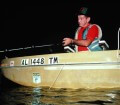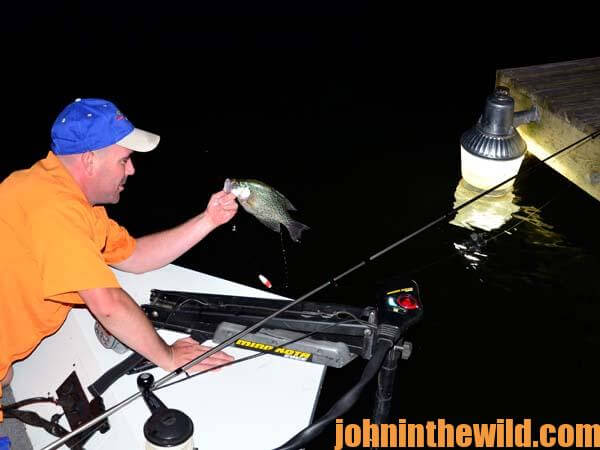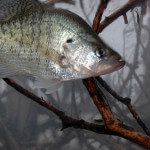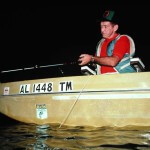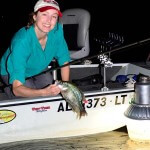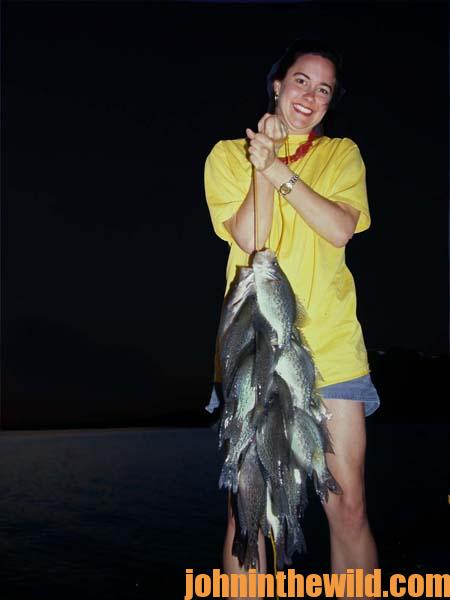 Nighttime crappie aren’t that much different from daytime crappie, since they like to migrate up and down old creek and river channels, prefer to school-up around some kind of bottom structure and will feed where they find bait readily available. An angler who considers these ingredients easily can begin to diagram places on a lake or a river where he’s most likely to locate crappie at night. The easiest and simplest spots to find nighttime crappie in most areas are under bridges. Usually there’s a bridge piling within a few yards of the old river or creek channel, which is oftentimes where the most crappie will school-up at night and come to the lights following baitfish. If there is a concentration of bait under the bridges, crappie may be caught all the way from one bank to the other. Sometimes at bridges during the summertime, an angler almost can walk boat to boat across a river. Other spots that are less likely to be fished are the areas where creek channels run into river channels and have brush or stick-ups in them. The main ingredient for productive nighttime crappie fishing is a bottom break in 10-18 feet of water with brush or stumps on it.
Nighttime crappie aren’t that much different from daytime crappie, since they like to migrate up and down old creek and river channels, prefer to school-up around some kind of bottom structure and will feed where they find bait readily available. An angler who considers these ingredients easily can begin to diagram places on a lake or a river where he’s most likely to locate crappie at night. The easiest and simplest spots to find nighttime crappie in most areas are under bridges. Usually there’s a bridge piling within a few yards of the old river or creek channel, which is oftentimes where the most crappie will school-up at night and come to the lights following baitfish. If there is a concentration of bait under the bridges, crappie may be caught all the way from one bank to the other. Sometimes at bridges during the summertime, an angler almost can walk boat to boat across a river. Other spots that are less likely to be fished are the areas where creek channels run into river channels and have brush or stick-ups in them. The main ingredient for productive nighttime crappie fishing is a bottom break in 10-18 feet of water with brush or stumps on it.
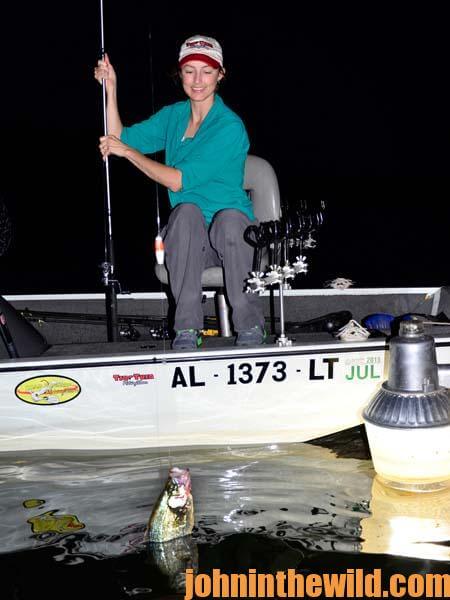 One of the greatest inventions for crappie fishermen is dusk-to-dawn dock lights. You must check this link right here now to understand more about dock lights. Many river and lake residents have this type of lights on the edges of their docks that come on at dusk 7 days a week and stay on until dawn. The crappie that come to dock lights have formed a pattern of moving to these lights every night to feed. The dock light is to the crappie fisherman what a green field is to a deer hunter – a place where you always can find feeding deer or crappie. One of the big advantages of fishing dock lights is that when one light stops producing crappie, you can move to another light. Over a period of several nights of fishing, you can find the lights that consistently produce the most and the biggest crappie every night you fish. Oftentimes, landowners on lakes and rivers may become irritated with anglers fishing around their lights and may come down to their dock and ask you to leave. However, this generally is not a major problem, because on most lakes and rivers across the U.S., there are always more dock lights to fish. Jonathon and Alicia Phillips, (no kin to the author but expert, avid crappiers), fish dock lights near Montgomery, Alabama. According to Phillips, “We can run a pattern of dock lights and catch a good mess of crappie almost any night we fish primarily with minnows. If the bite’s really good, we’ll use a Road Runner (www.ttiblakemore.com) jig tipped with a live shiner minnow.”
One of the greatest inventions for crappie fishermen is dusk-to-dawn dock lights. You must check this link right here now to understand more about dock lights. Many river and lake residents have this type of lights on the edges of their docks that come on at dusk 7 days a week and stay on until dawn. The crappie that come to dock lights have formed a pattern of moving to these lights every night to feed. The dock light is to the crappie fisherman what a green field is to a deer hunter – a place where you always can find feeding deer or crappie. One of the big advantages of fishing dock lights is that when one light stops producing crappie, you can move to another light. Over a period of several nights of fishing, you can find the lights that consistently produce the most and the biggest crappie every night you fish. Oftentimes, landowners on lakes and rivers may become irritated with anglers fishing around their lights and may come down to their dock and ask you to leave. However, this generally is not a major problem, because on most lakes and rivers across the U.S., there are always more dock lights to fish. Jonathon and Alicia Phillips, (no kin to the author but expert, avid crappiers), fish dock lights near Montgomery, Alabama. According to Phillips, “We can run a pattern of dock lights and catch a good mess of crappie almost any night we fish primarily with minnows. If the bite’s really good, we’ll use a Road Runner (www.ttiblakemore.com) jig tipped with a live shiner minnow.”
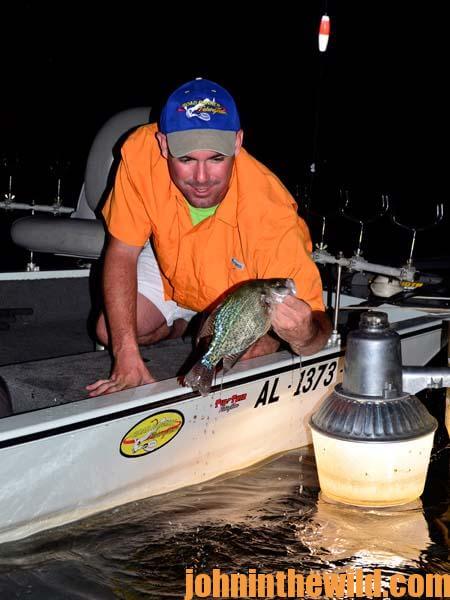 Another big advantage of fishing dock lights is that you don’t have to carry lights with you, and you don’t usually have to wait for the crappie to start biting. However, I’ve found that the best bite at most dock lights usually occurs between 10:30 pm and 3:30 am when the lake is quiet, most people are asleep, and the crappie usually don’t have any fishing pressure. If you’ve located several good dock lights on the body of water you fish, you may be able to get your limit of crappie every night you fish, between the hours suggested. Why fight the sun, the boat traffic, the jet and water skiers and other anglers to try and catch deep crappie during the summer months, when you can go out in the cool of the evening and find and catch crappie easier, faster and shallower than you can catch them in the daytime?
Another big advantage of fishing dock lights is that you don’t have to carry lights with you, and you don’t usually have to wait for the crappie to start biting. However, I’ve found that the best bite at most dock lights usually occurs between 10:30 pm and 3:30 am when the lake is quiet, most people are asleep, and the crappie usually don’t have any fishing pressure. If you’ve located several good dock lights on the body of water you fish, you may be able to get your limit of crappie every night you fish, between the hours suggested. Why fight the sun, the boat traffic, the jet and water skiers and other anglers to try and catch deep crappie during the summer months, when you can go out in the cool of the evening and find and catch crappie easier, faster and shallower than you can catch them in the daytime?
Use Lights at Night:
Although I have caught nice stringers of crappie using nothing but a Coleman lantern to attract bugs, which pull in shad that lure in crappie, I’ve also taken nice-size papermouths using nothing but floating lights to draw in microorganisms, thereby attracting shad and crappie. To increase my chances of taking more fish in a shorter time, I rig my boat with a lantern in the middle of boat and floating lights on either end. So, I take advantage of the best attributes of both lighting systems.
To learn much more about crappie fishing, get John E. Phillips’ Kindle eBooks and some print books, “Crappie: How to Catch Them Fall & Winter,” “Crappie: How to Catch Them Spring and Summer,” “Catch Cold Water Crappie Now” and “Catch Crappie All Year: Fishing a Single Pole, Using No Boat and Farming Crappie” by clicking here. To receive for free the “Crappie Catchers’ Cookbook,” by John and Denise Phillips that offers free recipes, click here.


